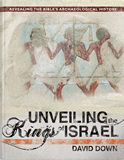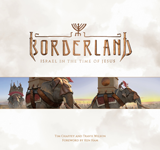
Understanding the Significance of Burial Traditions in the Gospel Accounts
The Gospels accurately describe a first-century burial
Abstract
The first sin mankind committed occurred in a garden, a perfect place God created (Genesis 2:8); the final nail in the coffin of sin also occurred in a garden, namely in a tomb where Jesus our Savior rose from the dead (John 19:41). Because of Adam and Eve’s sin, we experience death and, over the years, have developed ways to bury those we love as well as methods to mourn the loss and to cope with living on after we lose them. Probably the most famous death and burial accounts in all of history are found within the Gospels. The writers of the Gospels were real people who lived during the time of Christ and who practiced contemporary burial customs. These burial customs are important as they reflect the culture of the time and verify the testimony of the writers. In this paper, we will analyze the Gospel accounts and see that these eyewitness testimonies accurately reflect the burial culture of the first century AD.
What we know of first-century burial practices we receive primarily from the Gospels, Josephus, Rabbinic literature, and archaeology. The Gospels record eyewitness, first-hand accounts of the death, burial, and resurrection of Christ written only decades after his resurrection and reflect the culture and politics of that time. Flavius Josephus, a first-century historian, records vital political and cultural information that will also add greatly to the topic in his writings Jewish Antiquities, The Jewish Wars, and Against Apion books 1 and 2. Rabbinic literature, such as the Mishnah, was compiled in written form around AD 200.1 The Mishnah is based on what the rabbis called “oral Torah” or תורה שבעל–פה “Torah that is spoken.” Rabbinic literature provides vital cultural and religious information that corroborates with the Gospels. We will focus on the burial of Christ in this paper and how the Gospels accurately reflect first-century AD Jewish burial practices. Below, the Gospel accounts of Christ’s burial have been summarized and divided into key factors:
Burial Account Factors |
||||
|---|---|---|---|---|
Body of Christ |
Taken off the cross, wrapped in linen with spices, and placed in a tomb, per Jewish custom (Matthew 27:59–60; Mark 15:46; Luke 23:53; John 19:40–41). |
|||
Joseph of Arimathea |
Member of the local governing Jewish council, Sanhedrin (Mark 15:43; Luke 23:50) Did not agree with Jesus’ conviction (Luke 23:50–51) A righteous man who sought the kingdom of God (Mark 15:43; Luke 23:51) A disciple of Christ (Matthew 27:57; John 19:38) Requested the body from Pilate (Matthew 27:58; Mark 15:43; Luke 23:52; John 19:38) |
|||
Nicodemus |
Assisted Joseph of Arimathea by bringing about 70 lbs. of spices (John 19:39–40) A member of the Sanhedrin (John 19:39–40) Most likely another disciple of Jesus (John 3:1–10; 7:50–51) |
|||
Authorities |
Romans convicted Christ under Roman law (Matthew 27; Mark 15; Luke 23; John 18:28–19:42). Pharisees asked Pilate for a guard to secure the tomb (Matthew 27:62–66). |
|||
Tomb |
Owned by Joseph of Arimathea (Matthew 27:60) Nearby, in a garden, outside the city gates (John 19:20, 41; Hebrews 13:12) Newly cut in bedrock and had not been used (Matthew 27:60; Mark 15:46; Luke 23:53; John 19:41) Stone rolled to cover the entrance (Matthew 27:60; Mark 15:46; Luke 24:2; John 20:1) Most likely with a low door frame (John 20:5) Angels could be seen at the head and foot of where the body lay (John 20:12) |
|||
Culture of Burial in the First Century AD
When discussing the burial of Christ, we must first understand the culture surrounding the first century AD and how this affected the traditions surrounding death. Following the Babylonian exile, the Jews sought to preserve the religion, culture, and heritage of their ancestors written in the Old Testament/Tanakh.2 Judaism in the first century had many factions and sects, but the four most well-known were the Pharisees, Sadducees, Essenes, and Zealots. Each of these sects had their own views on death, burial, and resurrection. Acts 23:8 tells us, “For the Sadducees say that there is no resurrection, nor angel, nor spirit, but the Pharisees acknowledge them all.” We find that the Pharisees’ belief in individual, physical resurrection was the prominent view of Jews in the first century, while the Sadducees’ denial of the biblical origin of any resurrection was held by only a minority.3 Many of the mourning customs we find in Lamentations 2:10 (abstaining from washing, anointing, and wearing footwear, rending of garments, sackcloth being worn, the head bared and covered in ashes, and the mourners sitting on the bare ground) were adapted to fit a world that was Hellenized and a people under foreign rule. In the Mishnah, we read in the Tractate “Mourning” about a seven-day period of grieving called shivah (after the Hebrew word שבע meaning seven). The shivah began with burial of the deceased. During this period, immediate family would refrain from work: they would sit at home on low couches, heads covered, receiving condolences of relatives and friends.4 We see possible evidence of this practice in John 11. A man named Lazarus had been buried for four days. His sisters Mary and Martha were in their home grieving, and many of the Jews came to their home to comfort them. This tradition is believed to have originated from Job 2:13 and Genesis 50:10 where those who mourned did so for seven days. After this seven-day period, the shloshim (after the Hebrew word שלשים meaning 30) began.5 This 30-day period forbade immediate family members from leaving town, cutting their hair, or attending social gatherings; after these thirty days, the immediate family could continue their lives in a more normal fashion.6 This tradition was expanded to encompass up to a year’s worth of mourning where at the end of 12 months the family members would then gather the bones of their loved one and store them in their final resting place, the family tomb.7 Secondary burial was primarily practiced by Jerusalemite Jews but also existed in other parts of the country and eventually died out of practice in the first part of the third century AD.8 The Essenes, who did not believe in a physical resurrection but believed only the soul would continue to judgment or reward, did not practice this secondary burial custom but typically buried their dead directly in the ground in simple, individual graves.9,10
Jewish Burial Practices
According to the Gospels, the body of the deceased was washed and then anointed with spices, wrapped in linen, then a processional of the immediate family or other mourners would walk the body to the gravesite.11 The body was laid to rest either in a single grave in the ground (if you did not have a family tomb), or the bodies were placed in tombs carved out of the bedrock in niches. In Hebrew, these are called kokhim,12 or loculi13 in Latin, which translated means “small places.”14

Example of Second Temple kokhim/loculi tombs on Mt. Scopus, Israel. Note the “U” shaped, simple benches lining the walls. Image by Derek Winterburn, CC BY-ND 2.0, via Flickr.
Often these niches radiated off a central chamber that was lined with benches in a U-shaped design. Sometimes benches/shelves cut out of the wall of the tomb, called arcosolia, were used to either store a coffin (made either of limestone or pine) or to lay a body.15

First Century Jewish ossuaries with archosolia benches and arches behind with imbedded kokhim. Tamarah, CC BY-SA 3.0, via Wikimedia Commons.
Typically, burial was done in two stages. The first stage of burial we read in the Gospel of John recounts that the body of Jesus was taken down off the cross. Nicodemus and Joseph used spices they brought (around 75 pounds worth of aloes and myrrh) and linen cloths to bind the body of Christ. He was then laid to rest in a tomb sealed with a large stone.16 The first stage of burial and mourning is also attested in John 11 where it describes Lazarus, whom Jesus raised from the dead, as being buried with his hands and feet wrapped in strips and his face covered with a cloth. From the biblical account, we can surmise that Jesus was not laid in a kokhim because we are told in John 20:12 that “she saw two angels in white, sitting where the body of Jesus had lain, one at the head and one at the feet.” Someone could not sit at the head and foot of a kokhim as it is a shaft. Also, many (though not all) arcosolia have low ceilings that could prevent someone from sitting at the head and foot of the burial spot. So it is possible that Jesus was laid on a simple bench that lined many of the tomb walls during that period.17 This concluded the first stage of burial. The second stage of the burial process consisted of gathering the bones of the deceased after a year and depositing them into an ossuary (small chest).
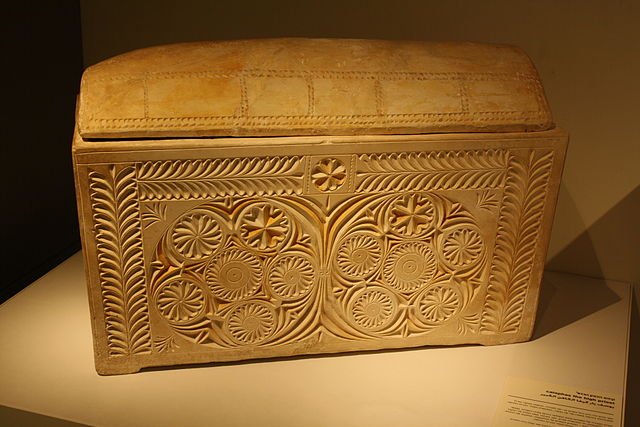
Ossuary of Caiaphas, first century AD. BRBurton, CC0, via Wikimedia Commons.
This would be the final resting place of the individual’s remains and the conclusion of the families mourning period.18 However, since we know that Jesus resurrected, there was no need for a secondary burial; therefore, there was no need for an ossuary in his case. Now that we have discussed first century burial practices, an important question remains. Was it likely that a crucified Jewish prisoner would be allowed a proper burial?
Did Jesus Receive a Jewish Burial?
According to many skeptics, since the Romans allowed the bodies of crucified victims to remain on the crosses till they rotted or piled them in mass graves for scavengers to consume, Jesus could not have received a proper Jewish burial.19 But according to the law in Deuteronomy 21:22–23, the body of a criminal was not to remain unburied, but rather should be interred the same day. According to Rabbinic tradition, there were four methods of capital punishment should someone be condemned under Jewish law: stoning, burning, killing by decapitation, and strangulation.20 The Mishnah states that the Sanhedrin had a designated place for burying bodies of executed criminals in order for their bodies to desiccate before their bones could then be collected and returned to their families for burial in their family tombs.21 These graves used for criminals under Jewish law did not apply to Jesus since we know from the biblical account that his execution was under Roman jurisdiction and not Jewish law, which is why Joseph of Arimathea, a member of the Sanhedrin, sought out permission from the Roman authorities to allow Jesus to be buried in his own tomb.22 In Mark 15:43, we read, “Joseph of Arimathea, a respected member of the council, who was also himself looking for the kingdom of God, took courage and went to Pilate and asked for the body of Jesus.” This passage as well as the three other Gospels testify that Jesus was falsely convicted under Roman law, and therefore, his corpse was under Roman control. Josephus sheds light upon the political and social practices of the Romans during that time. He writes,
We ought rather to have admired the magnanimity and modesty of the Romans, whereby they do not compel those that are subject to them to transgress the laws of their countries, but are willing to receive the honors due to them after such a manner as those who are to pay them esteem consistent with piety and with their own laws; for they do not thank people for conferring honors upon them, when they are compelled by violence so to do. (Ag. Ap. 2.73)
This statement supports the Gospel accounts that the Roman authorities, upon request, especially by privileged and wealthy individuals, would allow the Jews to perform their customs as they saw fit. With such a high-profile figure, Pilot would have been foolish not to allow Jesus a proper burial, and after confirming Christ was in fact dead by the centurion on duty, he gave his permission for Joseph to take the body.
Another crucial, cultural element of the burial of Christ is that the tomb was sealed with a large stone over the entrance. In Matthew 27, we read that after Joseph had taken the body and placed it in the tomb, the Pharisees approached Pilate asking for the tomb to be guarded lest the disciples steal the body and claim Christ resurrected, “So they went and made the tomb secure by sealing the stone and setting a guard” (Matthew 27:66). It would be reasonable to assume the stone blocking the entrance to the tomb was circular because the Bible describes it as being “rolled away.”23 During the first century, most stones were square and used like a plug, and it seems that round blocking stones were very rare and only appeared in front of the tombs of the wealthiest Jews.24 We read in Matthew 27:57 that Joseph of Arimathea was a “rich man,” and he apparently had enough status to obtain a private audience with Pontius Pilate. Considering these points, it is likely that the stone which blocked Jesus’ tomb was similar to the rare 2% of round stones found in Jerusalem that block the tombs of the wealthy.25

Jewish tomb from the time of Jesus with a massive rolling stone to seal it. Matson Collection, Public domain, via Wikimedia Commons
But Jesus was not from a wealthy family, so how could he receive a burial such as described in the Gospels? As we have already read, Joseph of Arimathea was wealthy and took it upon himself to ensure that Jesus’ body received every rite possible in the short amount of time before the Sabbath. The Gospels accurately reflect the culture and traditions of first-century Jerusalem, and archaeology supports the Gospel account of Jewish individuals receiving a proper burial after execution by crucifixion.
In 1968, archaeologists working in Givat ha-Mivtar, a suburb in Jerusalem, discovered a sealed first-century AD family tomb that contained 12 burial niches. Within one of these niches, they discovered an ossuary, with an inscription that reads יהוחנן בן הגקול or Jehohanan ben Hagakol.26
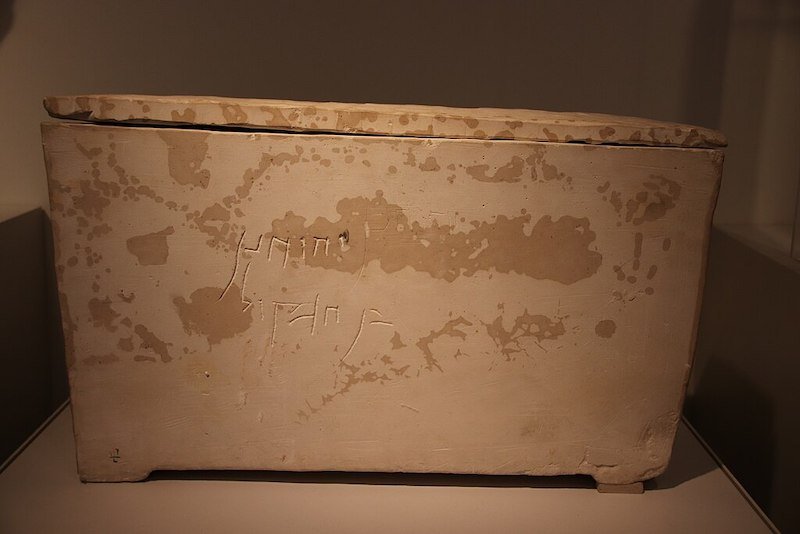
Jehohanan Ossuary. Israel Museum, CC0, via Wikimedia Commons
Israeli archaeologist Yigael Yadin proposed that Hagakol could be a nickname given posthumously meaning “the one hanged with knees apart.”27 This name could be significant as within this ossuary they found the bones of possibly three people—one of which was a male (approximately 28 years old). The man’s calcaneal (heel) bone had a 4 1/2-inch nail embedded into it.

Israel Museum, CC0, via Wikimedia Commons.
This is an amazing find as it is the first physical evidence of a crucified victim in the land of Israel and sheds light on how Christ may have been crucified. This find also supports the biblical account that some of those crucified could receive a Jewish burial.28
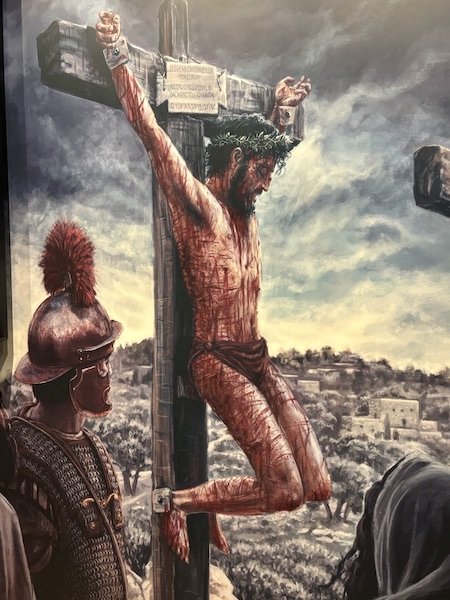
Artist’s interpretation of crucifixion based on Jehohanan heel bone. Photo by Corey East.
You might wonder, why is all this cultural and archaeological support important? The Apostle Paul writes in 1 Corinthians 15:3–4,
For I delivered to you as of first importance what I also received: that Christ died for our sins in accordance with the Scriptures, that he was buried, that he was raised on the third day in accordance with the Scriptures.
The cultural, political, and archaeological details of the biblical account surrounding the death, burial, and resurrection of Christ matter because they support the eyewitness testimony of the Gospels. The writers of the Gospels showed knowledge of first century burial practices. If these accounts were written even 200 years later, the burial practices would have been described differently thereby reflecting the later culture.29 Jesus Christ died and was buried in a tomb according to the practices at that time. And the disciples who claimed to be eyewitnesses30 reported the glory of Christ in their accounts in order that we “may have certainty concerning the things you have been taught.”31
Answers in Depth
2024 Volume 19
Answers in Depth explores the biblical worldview in addressing modern scientific research, history, current events, popular media, theology, and much more.
Browse VolumeFootnotes
- Avram R. Shannon, “Rabbinic Literature and the New Testament,” in New Testament History, Culture and Society: A Background to the Texts of the New Testament, ed. Lincoln H. Blumell (Religious Studies Center, Brigham Young University; Salt Lake City: Deseret Book, 2019), 122–140. Selection can be viewed at https://rsc.byu.edu/new-testament-history-culture-society/rabbinic-literature-new-testament.
- Tanakh: Torah—first five books of the bible, Nevi’im—Prophets, Ketuvim—Writings.
- L. Y. Rahmani, “Ancient Jerusalem’s Funerary Customs and Tombs: Part One,” The Biblical Archaeologist 44, no. 3 (July 1981): 174, https://doi.org/10.2307/3209608.
- Rahmani, “Ancient Jerusalem’s Funerary Customs.”
- “Moed Katan 27B:15.”
- Rahmani, “Ancient Jerusalem’s Funerary Customs,” 175.
- Rahmani, “Ancient Jerusalem’s Funerary Customs,” 175.
- Rahmani, “Ancient Jerusalem’s Funerary Customs.”.
- Rachel Hachlili, “Burial Practices at Qumran,” Revue de Qumrân 16, no. 2 (62) (December 1993): 253, http://www.jstor.org/stable/24609141.
- Jason M. Silverman, “Afterlife and Resurrection Beliefs in the Second Temple Period,” The Bible and Interpretation, January 14, 2020, https://bibleinterp.arizona.edu/articles/afterlife-and-resurrection-beliefs-second-temple-period.
- Luke 7:14.
- ThoughtHub, “The Tomb of Jesus: First Century Jewish Burials,” SAGU, March 24, 2016, https://www.sagu.edu/thoughthub/the-tomb-of-jesus-first-century-jewish-burials/.
- Andrea M. Berlin, “Power and Its Afterlife: Tombs in Hellenistic Palestine,” Near Eastern Archaeology 65, no. 2 (June 2002): 138–148, https://doi.org/10.2307/3210875.
- Berlin, “Power and Its Afterlife.”
- Matt Dawson, “Jesus’s Resurrection: An Archaeological Analysis,” Answers Research Journal 14 (May 2021): 125–157, https://answersresearchjournal.org/resurrection-archaeological-analysis/; Richard Neitzel Holzapfel, Jeffrey R. Chadwick, Frank F. Judd Jr., and Thomas A. Wayment, “Jesus and the Ossuaries: First-Century Jewish Burial Practices and the Lost Tomb of Jesus,” in Behold the Lamb of God: An Easter Celebration (Provo, UT: Religious Studies Center, Brigham Young University, 2008), 201–236. Also available to view at https://rsc.byu.edu/behold-lamb-god/jesus-ossuaries-first-century-jewish-burial-practices-lost-tomb-jesus.
- See “Burial Account Factors” chart.
- Dawson, “Jesus’s Resurrection: An Archaeological Analysis,” 131.
- Richard Neitzel Holzapfel, Jeffrey R. Chadwick, Frank F. Judd Jr., and Thomas A. Wayment, “Jesus and the Ossuaries: First-Century Jewish Burial Practices and the Lost Tomb of Jesus,” in Behold the Lamb of God: An Easter Celebration (Provo, UT: Religious Studies Center, Brigham Young University, 2008), 214-217, https://rsc.byu.edu/behold-lamb-god/jesus-ossuaries-first-century-jewish-burial-practices-lost-tomb-jesus.
- John Dominic Crossan, Who killed Jesus? Exposing the Roots of Anti-Semitism in the Gospel Story of the Death of Jesus, (New York: HarperOne, 1995), 160–188.
- Sefaria, “Mishnah Sanhedrin 7:1,” Koren–Steinsaltz, accessed February 16, 2024, https://www.sefaria.org/Mishnah_Sanhedrin.7.1?lang=bi.
- Sefaria, “Mishnah Sanhedrin 6:5–6,” Koren—Steinsaltz, accessed February 16, 2024, https://www.sefaria.org/Mishnah_Sanhedrin.6.5?lang=bi
- Mark 15:43.
- Mark 16:4
- Dawson, “Jesus’s Resurrection: An Archaeological Analysis,” 143.
- Randall Price and H. Wayne House, Zondervan Handbook of Biblical Archaeology (Grand Rapids, MI: Zondervan, 2017), 258–261.
- L. Y. Rahmani, “Ancient Jerusalem’s Funerary Customs and Tombs: Part Three,” The Biblical Archaeologist 45, no. 1 (January 1982): 51–52, https://doi.org/10.2307/3209848.
- Yigael Yadin, “Epigraphy and Crucifixion,” Israel Exploration Journal 23, no. 1, (1973): 18–22, https://www.jstor.org/stable/27925370.
- John J. Davis, “Rethinking the Crucified Man from Giv’at ha-Mivtar,” New Testament Era, Associates for Biblical Research, October 15, 2009, https://biblearchaeology.org/new-testament-era-list/4185-rethinking-the-crucified-man-from-givat-hamivtar.
- Rahmani, “Funerary Customs and Tombs: Part 1,” 175.
- 2 Peter 1:16.
- Luke 1:4.
Recommended Resources

Answers in Genesis is an apologetics ministry, dedicated to helping Christians defend their faith and proclaim the good news of Jesus Christ.
- Customer Service 800.778.3390
- © 2024 Answers in Genesis



